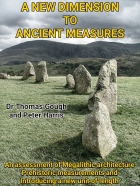| Author | The disco ball and the Grail |
jonm

Joined:
12-07-2011
Messages: 2326
from UK
 OFF-Line OFF-Line
|  Posted 15-07-2012 at 09:44 Posted 15-07-2012 at 09:44
In MPP's book on Stonehenge (published 2012), new dates for the use of copper in the UK now coincide with the construction of Stonehenge in its sarsen phase. Evidence of UK tin mining also appears to pre-date this phase by perhaps several centuries. Unlike copper, tin is a silvery metal with a low melting point which can easily be cast to form a flat surface and then polished by hand using only chalk paste:
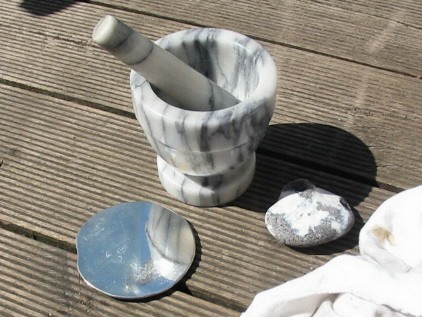
The technology of the Disco Ball:
Providing the dimensions are very similar or identical to those at Stonehenge, the solar invention described elsewhere in the forum can produce a very bright ‘mini-sun’.
You've all seen this before but insets for a 3-season device; three holes in a vertical line set dead south of the centre of the circle, are apparent in Stone 54. The holes are dead south of Stonehenge's centre:
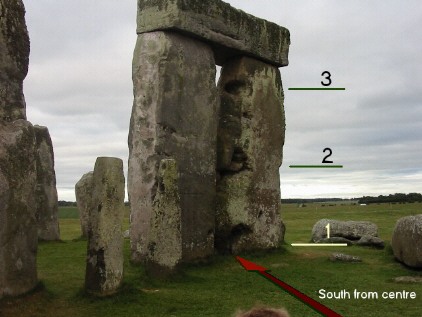
Making a bright ‘mini-sun’ requires some additional components to be brought in a procession to the inside of the castle-like round support structure. The list of extra parts needed is:
1: A tree-pole or giant lance, pointed to the North Star.
2: A hanger; rather like a candelabra because it carries a light and has a cross-bar which can be rotated.
3: The ‘Grand-œil’ reflector, possibly containing crystals.
4: A silvery dish composed of arrays of polished flat metal.
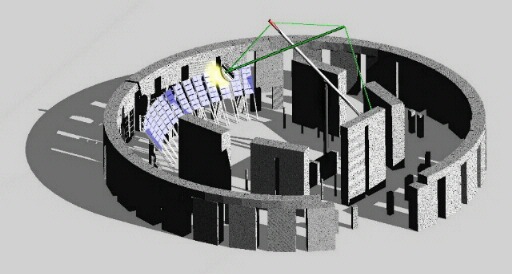
In the CGI above, the ‘lance’ holding the ‘candelabra’ is painted white, to fade against the background sky, with its tip in red to indicate the direction to the North Pole. The spherical dish of silvery mirrors are shown blue and the ‘candelabra’ is shown in green.
The Grail Procession of Arthurian Legend:
In the legend, the grail is accompanied by several other objects brought into the Fisher King's castle. Perceval could have restored the Fisher King by asking a question, but kept his silence and did not ask “Unto whom one serveth the grail?”. When Perceval awoke the next morning, the castle was empty.
At the castle, Perceval sees a strange procession passing by:
1) A squire with a white lance, from which a drop of blood falls on his hand;
2) two squires bearing candelabra;
3) a noble maiden carrying a graal, a receptacle set with precious gems and shedding a brilliant light;
4)another maiden with a platter of silver
Original quote in French here
In the original version, Chrétien did not write about the grail as if it were a religious object; later writers call it the ‘Holy Grail’.
Description of the system:
If a reflector is used with this device, the air around the ‘great eye’ of the reflector becomes hazy due to the concentrated sunlight (see other posts on the forum). The 'candelabra' pole constantly rotates to follow the sun; so the bright reflector would seem to be covered by haze and would appear to move with sunbeams, fading as they fade
Description of the Arthurian Grail:
In the book ‘Celtic Myth and Arthurian Romance’, the Grail's entry to Camelot is described:
Quote:
| It is Pentecost and Arthur and the knights of the round table are at Camelot. Every seat is full and because of this fulfilment Arthur states that "it is the hour of the Glory of Lorges (England)". Even as Arthur speaks "there blew a great wind about the castle and a mighty crash of thunder shook the place.: then on a sudden a sunbeam cut through the gloom from end to end of the great hall, seven times more clear than ever man saw on the brightest day of summer ... Then the Holy Grail entered into the hall covered in a cloth of white samite, so filled with glorious light that none might behold it. Nor could they see who carried the Holy Grail, for it seemed to glide upon the sunbeam ... then on a sudden it departed from amongst them, and none might see where it went: but the sunbeam faded also. |
|
(re-quoted from ‘The Celtic Gods’, by Professor M Baillie and P McCafferty)

I've put the rest of the quotes and links on this page: The Grail and the Disco Ball
A really neat set of extra coincidences for the disco ball idea, or could there be something more to Arthurian legend?
 Profile Profile
 Email Email
 Reply Reply
|
Feanor

Joined:
11-05-2011
Messages: 943
from Cape Cod Massachusetts, US
 OFF-Line OFF-Line
|  Posted 15-07-2012 at 16:42 Posted 15-07-2012 at 16:42
(Now I have to fish through a year's worth of posts on 10 threads and try to find where I originally used the phrase: "Disco Ball". Sheesh!)
Jon, several sets of extraordinary engineering coincidence do not an Arthurian Legend make, my friend.
I'm gonna play Devil's Advocate here:
The undeniable - seemingly inordinate - number of coincidences that initially bolster the SH Suspended Mirror Theory were discovered to occur completely out of context with the Monument. The material elements which make up the design are either inexpensive to purchase, or can be reproduced using materials and techniques we now know were available in the Neolithic.
Only then did you discover the remarkable resemblance to the Stonehenge Configuration.
Fair enough.
In writing The Broken Stone, you carefully led the Reader to install the various components to the purpose of more ably fitting the premise to the story. Good technique and well-done, I say. You don't change anything structural except by 'Biodegradable Addition'.
Then, with buried sub-text, you stitched known to the unknown in fitting the new SH construct to a mythos of The Grail. (The tailoring of which isn't particularly obvious to the Arthurian Legend-Challenged among us, so, again - well done!)
But one idea is fore-thought, the other after-thought.
As you may recall, with my initial review of the premise, I hammered at you for a week to tell me precisely When this coincidence occurred to you, ie: before or after you designed it.
This is why I have become so fascinated by it. You didn't know it was SH at the time you drew and built the working model in your back yard; the original purpose intended only as an engineering design for cheap solar collection & distribution.
Aligning this concept (pun intended) with Stonehenge was very serendipitous and has found a number of adherents. I add that it also has its fair share of detractors.
There are any number of sources which indirectly support the idea - the new time frames not the least. But short of finding tin-dust or confirmed grind-marks in S-54 it may be relegated to that nether region of curiously possible ideas that are, under the circumstances, yet to be DISproved. (Big pile!)
There is another person out there who is weaving a time-thread between Neolithic Wiltshire and the comparatively modern Arthur Stories.
My understanding of that story's motive is (in part) to illustrate that the Peoples of Neolithic UK were not the "Howling Savages" of recent popular view, but a thoughtful, clever and forward-thinking folk whose influence reaches from the Deep Past to connect with a more recognizable 'present'.
At perilous literary risk, the growing penchant for Simile and/or Allegory are rife - though not unknown or particularly eschewed in a Fiction context.
With one story, it makes a great Tale, enhancing an established allegory, is inclusive of mental illustration and colorful metaphor, while taking the Reader on a recognizable Journey of Connection with the Past.
The other threatens to unhinge an original, sober, and otherwise sound theory.
Personally, I would wait till after the MBE to pursue a Holy Blood angle.
Best wishes,
Neil
____________________
 Profile Profile
 Email Email
 Reply Reply
|
Runemage

Joined:
15-07-2005
Messages: 3926
from UK
 OFF-Line OFF-Line
|  Posted 15-07-2012 at 20:54 Posted 15-07-2012 at 20:54
Very interesting Jon!! Those descriptions are very very thought-provoking.
That's set me wondering now, did they have a method of transporting this light somehow?
Hi Feanor, Can you help me out here please 
I don't understand your ref to Holy Blood and the intimation towards the more fanciful/sensational theories. The grail as Jon's described from both sources is a vessel filled with unnaturally bright light, covered with a white cloth, accompanied by what could be the symbolic representations of his apparatus, nothing to do with the later religious blood or bloodline interpretation.
Rune
 Profile Profile
 Reply Reply
|
Feanor

Joined:
11-05-2011
Messages: 943
from Cape Cod Massachusetts, US
 OFF-Line OFF-Line
|  Posted 16-07-2012 at 03:36 Posted 16-07-2012 at 03:36
Quote:
|
On 2012-07-15 20:54, Runemage wrote:
Hi Feanor, Can you help me out here please 
I don't understand your ref to Holy Blood and the intimation towards the more fanciful/sensational theories. The grail as Jon's described from both sources is a vessel filled with unnaturally bright light, covered with a white cloth, accompanied by what could be the symbolic representations of his apparatus, nothing to do with the later religious blood or bloodline interpretation.
Rune
|
|
Hi Rune!
I posted: "(The tailoring of which isn't particularly obvious to the Arthurian Legend-Challenged among us ... )"
I believe this touches on my complete scholarly ignorance of the Grail Mythos or Legend. In so saying, I'm afraid I may indeed be subject to "the more fanciful/sensational theories".
Nevertheless, I will let my previous (above) remarks stand, as they broadly illustrate my view with regard to the peculiar double-allegory in Jon's work, the first of which is an overt and capable description of a workable Henge-Design.
Neil
 Profile Profile
 Email Email
 Reply Reply
|
jonm

Joined:
12-07-2011
Messages: 2326
from UK
 OFF-Line OFF-Line
|  Posted 16-07-2012 at 12:08 Posted 16-07-2012 at 12:08
Hi Neil
Quote:
| This is why I have become so fascinated by it. You didn't know it was SH at the time you drew and built the working model in your back yard; the original purpose intended only as an engineering design for cheap solar collection & distribution. |
|
That's right! The original idea of how to make this invention work occurred to me over three years before visiting Stonehenge. And worse, I was just about to apply for grant on the original 'test the water' patent so had to make a quick decision: What I wanted control of is so far removed from what you see in the old and current applications that you would have difficulty recognising why it's even relevant to Stonehenge.
Quote:
| There are any number of sources which indirectly support the idea - the new time frames not the least. But short of finding tin-dust or confirmed grind-marks in S-54 it may be relegated to that nether region of curiously possible ideas that are, under the circumstances, yet to be DISproved. (Big pile!) |
|
I'm not sure you can ever prove anything. For example, finding elevated levels of tin (or tin oxide) dust or even finding evidence of chafing or positioning damage at the base of the holes in stone 54: Would that actually prove anything?
Quote:
| With one story, it makes a great Tale, enhancing an established allegory, is inclusive of mental illustration and colorful metaphor, while taking the Reader on a recognizable Journey of Connection with the Past.
The other threatens to unhinge an original, sober, and otherwise sound theory. |
|
Unusual sets of allegorical coincidences make good fiction though? I know what you mean: Making obvious even just one of the "coincidences by allegory" is a risk compared to just sticking with fact and correlation.
But what if this were done at Stonehenge? This was the very first business consideration; even before the novel was considered. What if it were true, what if this was Stonehenge, what if we went ahead with patenting and then sell-on - and at a later date the idea itself was shown to be a valuable national asset? (but now lost for my remaining lifetime)
If this seems even vaguely possible, I reckon you have to go all out to tailor the initial stuff for as much disclosure as possible so that the applications can be questioned before a precedent is set: There was a two and a half year window to do that and it's one of the reasons that open access was offered to so many archaeological bodies and related organisations over the past two years or so (though the offer was not taken up).
Plus, with a bit of luck, the various allegories alluded to in the book might also help to sell a few more books!
Hi Rune
Quote:
| That's set me wondering now, did they have a method of transporting this light somehow? |
|
No, its a fixed event thing. The mirrors and apparatus needs an exceptionally rigid support construction to work properly under all circumstances.
 Profile Profile
 Email Email
 Reply Reply
|
Feanor

Joined:
11-05-2011
Messages: 943
from Cape Cod Massachusetts, US
 OFF-Line OFF-Line
|  Posted 16-07-2012 at 15:25 Posted 16-07-2012 at 15:25
Jon: Clever boy ...
I will do some research into the Grail so I'm not quite as ignorant.
Rune: You keep on jumping in to make the Olde Guy think! lol
 Profile Profile
 Email Email
 Reply Reply
|
ledgehammer

Joined:
29-06-2011
Messages: 779
from Sheffield
 OFF-Line OFF-Line
|  Posted 16-07-2012 at 16:56 Posted 16-07-2012 at 16:56
Quote:
|
On 2012-07-15 09:44, jonm wrote:
In MPP's book on Stonehenge (published 2012), new dates for the use of copper in the UK now coincide with the construction of Stonehenge in its sarsen phase. Evidence of UK tin mining also appears to pre-date this phase by perhaps several centuries. Unlike copper, tin is a silvery metal with a low melting point which can easily be cast to form a flat surface and then polished by hand using only chalk paste:

The technology of the Disco Ball:
Providing the dimensions are very similar or identical to those at Stonehenge, the solar invention described elsewhere in the forum can produce a very bright ‘mini-sun’.
You've all seen this before but insets for a 3-season device; three holes in a vertical line set dead south of the centre of the circle, are apparent in Stone 54. The holes are dead south of Stonehenge's centre:

Making a bright ‘mini-sun’ requires some additional components to be brought in a procession to the inside of the castle-like round support structure. The list of extra parts needed is:
1: A tree-pole or giant lance, pointed to the North Star.
2: A hanger; rather like a candelabra because it carries a light and has a cross-bar which can be rotated.
3: The ‘Grand-œil’ reflector, possibly containing crystals.
4: A silvery dish composed of arrays of polished flat metal.

In the CGI above, the ‘lance’ holding the ‘candelabra’ is painted white, to fade against the background sky, with its tip in red to indicate the direction to the North Pole. The spherical dish of silvery mirrors are shown blue and the ‘candelabra’ is shown in green.
The Grail Procession of Arthurian Legend:
In the legend, the grail is accompanied by several other objects brought into the Fisher King's castle. Perceval could have restored the Fisher King by asking a question, but kept his silence and did not ask “Unto whom one serveth the grail?”. When Perceval awoke the next morning, the castle was empty.
At the castle, Perceval sees a strange procession passing by:
1) A squire with a white lance, from which a drop of blood falls on his hand;
2) two squires bearing candelabra;
3) a noble maiden carrying a graal, a receptacle set with precious gems and shedding a brilliant light;
4)another maiden with a platter of silver
Original quote in French here
In the original version, Chrétien did not write about the grail as if it were a religious object; later writers call it the ‘Holy Grail’.
Description of the system:
If a reflector is used with this device, the air around the ‘great eye’ of the reflector becomes hazy due to the concentrated sunlight (see other posts on the forum). The 'candelabra' pole constantly rotates to follow the sun; so the bright reflector would seem to be covered by haze and would appear to move with sunbeams, fading as they fade
Description of the Arthurian Grail:
In the book ‘Celtic Myth and Arthurian Romance’, the Grail's entry to Camelot is described:
Quote:
| It is Pentecost and Arthur and the knights of the round table are at Camelot. Every seat is full and because of this fulfilment Arthur states that "it is the hour of the Glory of Lorges (England)". Even as Arthur speaks "there blew a great wind about the castle and a mighty crash of thunder shook the place.: then on a sudden a sunbeam cut through the gloom from end to end of the great hall, seven times more clear than ever man saw on the brightest day of summer ... Then the Holy Grail entered into the hall covered in a cloth of white samite, so filled with glorious light that none might behold it. Nor could they see who carried the Holy Grail, for it seemed to glide upon the sunbeam ... then on a sudden it departed from amongst them, and none might see where it went: but the sunbeam faded also. |
|
(re-quoted from ‘The Celtic Gods’, by Professor M Baillie and P McCafferty)

I've put the rest of the quotes and links on this page: The Grail and the Disco Ball
A really neat set of extra coincidences for the disco ball idea, or could there be something more to Arthurian legend?
|
|
Jon,
very interesting!
Tom
 Profile Profile
 Reply Reply
|
jonm

Joined:
12-07-2011
Messages: 2326
from UK
 OFF-Line OFF-Line
|  Posted 17-07-2012 at 13:22 Posted 17-07-2012 at 13:22
Thanks Tom! I seem to have become a 'documentary consultant' on Stonehenge as of today.
There's a few more interesting coincidental bits and pieces to come. It's a shame that the sequence you have to follow with these things takes so many years to complete.
All the best
Jon
 Profile Profile
 Email Email
 Reply Reply
|
jonm

Joined:
12-07-2011
Messages: 2326
from UK
 OFF-Line OFF-Line
|  Posted 24-07-2012 at 11:05 Posted 24-07-2012 at 11:05
I'm thinking of constructing a scale model to demonstrate how it works: I'm particularly interested in using crystals to see what effect it produces and I also want to construct it in a "Stonehenge-like" manner so that motors are not needed. All the kit for doing a reconstruction is in storage and, despite being stacked away for the last four years or so, all looks to be in pretty good condition.
We'll probably do this over on the South Coast (it's a long way to Stonehenge and there's no commercial interest from that neck of the woods).
The arrangement would be configured so that it rises upwards from midday to dusk (using the same system arrangement as at Stonehenge): Makes it a bit easier time-wise than trying to go with the "down then up" morning-afternoon configuration of the original prototypes.
Would there be any interest from here in seeing the first run of the "shining eye's" rising?
 Profile Profile
 Email Email
 Reply Reply
|
Feanor

Joined:
11-05-2011
Messages: 943
from Cape Cod Massachusetts, US
 OFF-Line OFF-Line
|  Posted 24-07-2012 at 17:32 Posted 24-07-2012 at 17:32
Yes.
 Profile Profile
 Email Email
 Reply Reply
|
Andy B

Joined:
13-02-2001
Messages: 12290
from Surrey, UK
 OFF-Line OFF-Line
|  Posted 24-07-2012 at 20:22 Posted 24-07-2012 at 20:22
Heh - I seem to have become a 'modern stone circle' consultant for the New York Times 
 Profile Profile
 Email Email
 Reply Reply
|
Runemage

Joined:
15-07-2005
Messages: 3926
from UK
 OFF-Line OFF-Line
|  Posted 24-07-2012 at 21:45 Posted 24-07-2012 at 21:45
Would there be any interest from here in seeing the first run of the "shining eye's" rising?
Yes please, it's too far away for me to go in person but I'd love to see a video if possible?
Rune
 Profile Profile
 Reply Reply
|
Feanor

Joined:
11-05-2011
Messages: 943
from Cape Cod Massachusetts, US
 OFF-Line OFF-Line
|  Posted 24-07-2012 at 23:35 Posted 24-07-2012 at 23:35
Cheers to Our Fearless Leader Landrew and the NYT!
Excellent!
I, on the other hand, have been asked to verify certain physical aspects of the new Foam Henge Tour thingy - so there!
Nyah Nyah!
(LOL!)
[ This message was edited by: Feanor on 2012-07-24 23:36 ]
 Profile Profile
 Email Email
 Reply Reply
|
jonm

Joined:
12-07-2011
Messages: 2326
from UK
 OFF-Line OFF-Line
|  Posted 25-07-2012 at 09:26 Posted 25-07-2012 at 09:26
Good going Andy!
I spent a lot of yesterday evening being a consultant to my youngest son on how to get Microsoft Windows working again. I now have brain-ache.
Gone through the figures: I think it'll need to be 3/10th scale: Luckily the panels of the original prototypes were done as segments so can be split up. The Winter setup is easier to do than the equinoxes or summer, so I'll probably aim for that period (not sure which year though).
Will definitely video it Rune. Might also try to do time-lapse; the surveying tripods don't get much use these days.
 Profile Profile
 Email Email
 Reply Reply
|
jonm

Joined:
12-07-2011
Messages: 2326
from UK
 OFF-Line OFF-Line
|  Posted 10-08-2012 at 19:15 Posted 10-08-2012 at 19:15
Sourced all the main components for the arrangement, but decided on 1/3rd scale rather than 3/10. Funny thing is that the thing I thought would be the easiest to get hold of turns out to be the hardest (I managed to acquire a full sailing mast, will all the kit, and a boom of the right length, during the same week that I started to look).
But, having some difficulty sourcing something which looks like this:
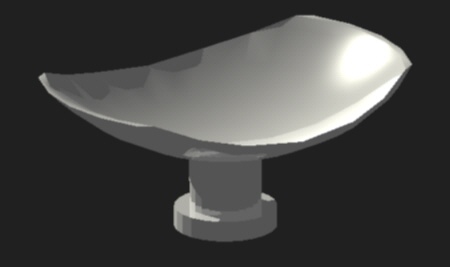
It never was a disco ball as such: It needs to be more of a shallow cup, with just the right shape, for the prototype application (where I'll be creating a dazzling light which appears to glide on sunbeams, fading as they fade). Trouble is that it could get too hot unless it's made of well polished pure metal (silver would be the best but I'm not buying a 12" silver cup for this!).
Any ideas of something industrial which looks like this (steel would probably do) and could be polished or ground to a shine?
Jon
 Profile Profile
 Email Email
 Reply Reply
|
Runemage

Joined:
15-07-2005
Messages: 3926
from UK
 OFF-Line OFF-Line
|  Posted 11-08-2012 at 09:00 Posted 11-08-2012 at 09:00
Do you have an art college nearby Jon, they often have sheet metals for jewellery and sculpture projects, perhaps they could source you some if they don't have it in stock, or refer you to a supplier.
Rune
 Profile Profile
 Reply Reply
|
Feanor

Joined:
11-05-2011
Messages: 943
from Cape Cod Massachusetts, US
 OFF-Line OFF-Line
|  Posted 11-08-2012 at 14:40 Posted 11-08-2012 at 14:40
Jon, you live near the Channel if memory serves.
Go find a boat-works in your area and have them fabricate a small sheet of 3/16" Anodized Aluminum to the appropriate shape-requirements.
Have a Yolk Fitting & Collar made of 2" O.D. black gas-pipe; Hardened Steel. Coarse thread on either end.
Fix the Yolk & Collar to a small 1/4 " Schedule-40 back-plate and have it spot-welded to the Aluminum.
(3/8" x 3/4" counter-sunk Pan-Head screws will also work if the weld won't bite the Aluminum. I can't remember the chemical spec off the top of my head.)
Fix a 12-inch pole into the gas-pipe and then put a butterflied 180 knuckle-joint to the end. (Make it a Universal-Joint it you want to get really sexy.) Fix the remaining required length of pole into the other end of this joint. (At this point, the pole can be made of anything, having shed the collected heat through the steel and joint, which will double as sinks.)
The whole thing will weigh less than 8 pounds, without the pole, and can be site-assembled in a trice.
The joint acts as a further refinement to focusing the concave plate to the mirrors, and provide the ability to send the focused, reflected beam to an off-site receiver.
(Cylinder of water/ stack of glass blocks, et.al. )
Neil
___________________________
 Profile Profile
 Email Email
 Reply Reply
|
jonm

Joined:
12-07-2011
Messages: 2326
from UK
 OFF-Line OFF-Line
|  Posted 13-08-2012 at 14:48 Posted 13-08-2012 at 14:48
Thanks Guys
I was thinking of going for inexpensive as possible with this one: Something similar but not exact.
A round 'disco ball' plays light out everywhere. A concentrator placed in front of the focal intersection (my current plan) spays it forwards but doesn't concentrate it a great deal:
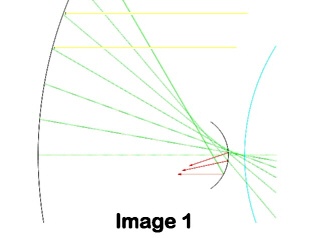
The alternative is to place the reflector behind the intersection point. This can do the job, but the back disk (such as at the Aceribo Spherical Concentrator Observatory) becomes too large for a spherical line array because it throws too much shadow onto the mirrors you're trying to get focus from:
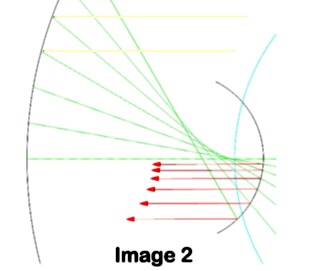
Yet another way is to go for a combination of front and rear reflector together with rings to form diffusion baffles:
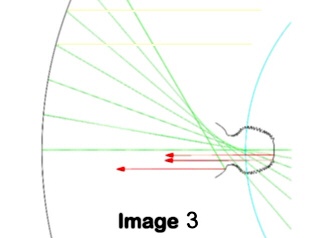
This would do a much better job of throwing concentrated light straight down a line or Avenue, so is what I'd probably go for if I was going to get anything fabricated (rather than 'near enough'):
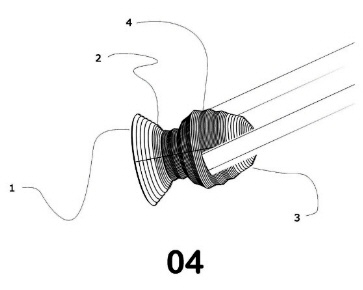
(1: Is like a dish with a hole in it. 3 is also a curved dish shape and 2 and 4 are a collar and back reflector, preferably with grooved baffles to internally reflect the light about until it got to an angle that it could get out of the collar: This assembly makes a bell-shaped concentrator.)
The big problem with this is that you need high internal reflectivity, so there aren't many metals or alloys that would do the job. (wikipedia: reflectivity). Gold is the only really good metal for this and it would throw out a bright yellow concentrated light:
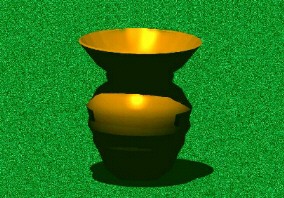
 Profile Profile
 Email Email
 Reply Reply
|
Feanor

Joined:
11-05-2011
Messages: 943
from Cape Cod Massachusetts, US
 OFF-Line OFF-Line
|  Posted 13-08-2012 at 23:33 Posted 13-08-2012 at 23:33
So then ...
No longer do we have the much-touted silver Disco Ball.
Now we have devolved into the gold Spittoon?
 Profile Profile
 Email Email
 Reply Reply
|
jonm

Joined:
12-07-2011
Messages: 2326
from UK
 OFF-Line OFF-Line
|  Posted 14-08-2012 at 14:01 Posted 14-08-2012 at 14:01
the gold Spittoon
Great name! But the great disco ball arrangement does have a weird use which also duplicates a different legend (an idea for kicking about after a few drinks)
Jon
 Profile Profile
 Email Email
 Reply Reply
|
|







